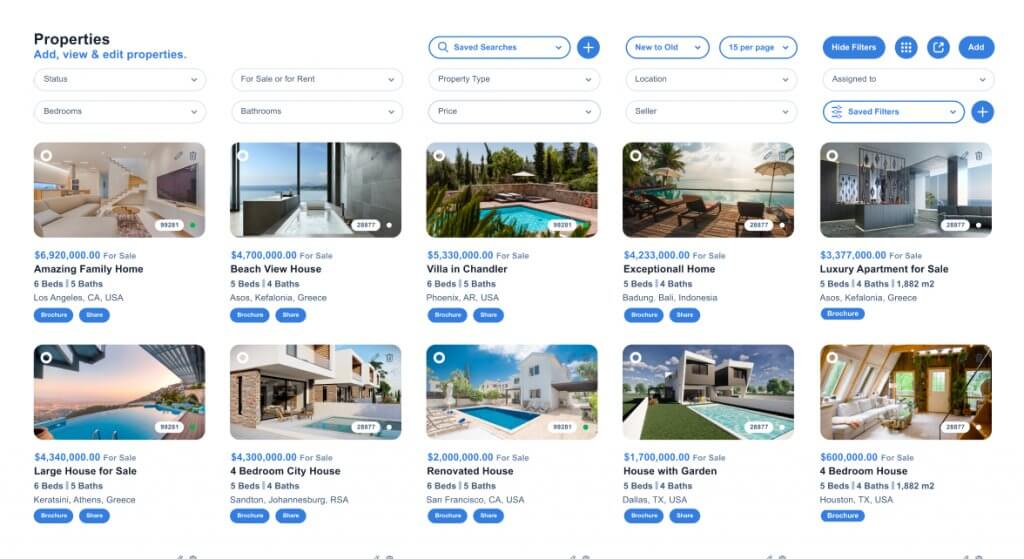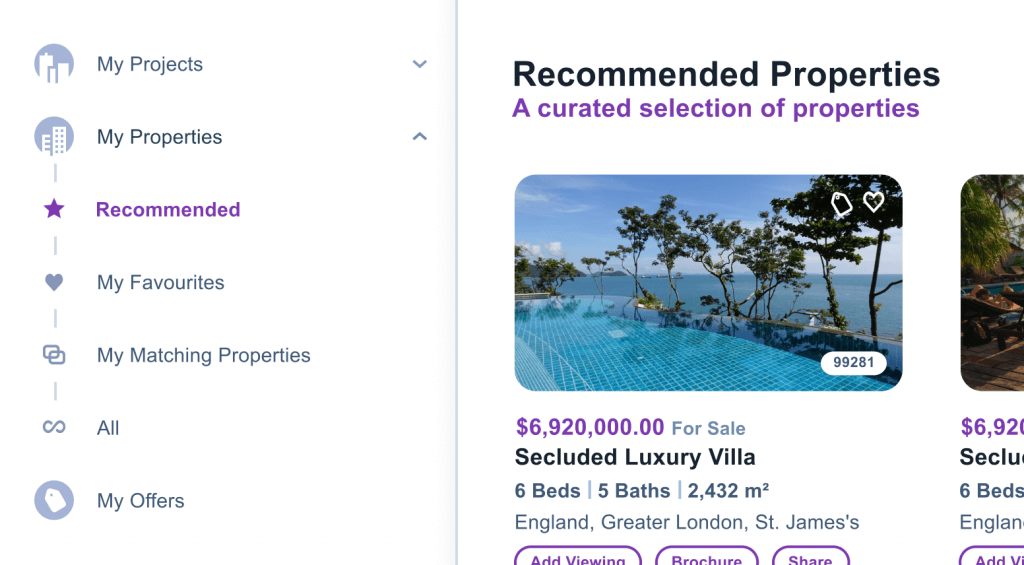Real Estate CRM software and MLS integration offers real estate professionals a wider pool of properties to sell to potential homebuyers, increasing sales and profitability.
In this blog we’ll look at what an MLS is, where they are used worldwide, how they differ from real estate websites, and why CRM/MLS integration is vital for your real estate business.
Table of Contents
1. What is an MLS (multiple listing service)?
2. What information does an MLS provide?
3. What roles exist in an MLS?
4. Where are MLSs most popular?
5. How valuable are MLS’?
6. The use of IDX programs by MLS’
7. Is an MLS the same as a real estate website?
8. How are properties listed on real estate websites?
9. How do real estate websites perform in the United States?
10. Why integrate your Real Estate CRM with an MLS?
11. Conclusion
1. What is an MLS (multiple listing service)?
Investopedia defines a multiple listing service (MLS) as “a database established by cooperating real estate brokers to provide data about properties for sale. It allows brokers to see one another’s listings of properties for sale with the goal of connecting homebuyers to sellers. Under this arrangement, both the listing and selling broker benefit by consolidating and sharing information, and by sharing commissions.”
2. What information does an MLS provide?
According to a recent Homelight article, “the MLS contains information and statistics about a listing, such as price, bedrooms, bathrooms, days on the market, property taxes, and listing agent information.” Data that would put a sellers’ privacy or safety at risk like seller contact information and times the home is vacant for showings, is not publicly accessible. [NAR].
3. What roles exist in an MLS?
Brokers in an MLS are called participants, and agents are called subscribers. Agents cannot join an MLS unless their broker does so first. Homeowners can work with a real estate broker to list their homes on the MLS. Only participating brokers can list properties on the MLS.
“Typically, real estate brokers work together in their local areas to create their own regional MLS. As a result, there are hundreds of regional databases that comprise all of the national listings found on various realtor websites.” [Investopedia]
4. Where are MLSs most popular?
As of 2020, RESO reports that there are almost 600 MLSs in the United States. “More than 80 percent of homes sold in the U.S. are on an MLS. In most other countries, MLSs either do not exist or they are not as popular as in North America.”
The exception is Spain in Europe in which MLSs have reportedly been used since 2002.
5. How valuable are MLSs?
The National Association of Realtors (NAR) found that 64% of its members considered local MLS websites/apps to be one of their 3 most important technology tools. Other technologies included lockbox/smart key devices (39%), and social media platforms (28%).
6. The use of IDX programs by MLSs
MLSs also use Internet Data Exchange (IDX) programs to boost cooperation between realtors®. Under IDX, brokers give each other consent to display each other’s listings on participants’ websites and to use applications for mobile devices that participants control. Many MLSs also provide listing information to 3rd-party aggregators like realtor®.com and others through syndication or other similar type agreements. This can only be done with the consent of the broker. [NAR]
7. Is an MLS the same as a real estate website?
The quick answer is no. Think Zillow.com, Trulia.com, Realtor.com, Homes.com, Yahoo! Homes. These are very popular real estate websites that get some of their listing data from MLSs, but they’re not MLSs themselves. They’re advertising portals and brokerage websites with permission to display real estate listings.
UK based Emoov expands on this in a little more detail, “real estate portals host properties advertised by estate and letting agents, for sale and for rent. Someone seeking a property will visit the portal and select the area they’re interested in. Ideally, once they’ve found a property they like, they’ll submit an enquiry which goes to the agent advertising the property. The agent will contact the potential homebuyer to arrange a viewing.”
8. How are properties listed on real estate websites?
Real estate websites fill their inventory of homes in several ways. Input could be manual. Alternatively, a realtor or property manager updates a home’s profile or a seller uploads pictures. Sometimes, updates happen digitally through each company’s proprietary algorithm or via their CRM system which is integrated with their website. Buyers or renters are usually able to utilise most of these sites for free, unless they want to use features like saving search criteria or getting push notifications when prices to properties are lowered, etc. Sellers are often charged to list their homes for sale, and a renter may have to pay a fee if they wish to apply for an apartment. [Investopedia]
9. How do real estate websites perform in the United States?
Statistica reveals some interesting stats in this regard, “Throughout 2022, Zillow was the most popular real estate website in the United States. Monthly, Zillow received about 60 million visits, which was substantially higher than any other website in the ranking. The runner-up Realtor.com received about 40 million monthly visits and Trulia, which came third in the ranking, received close to 21 million visits.”
10. Why Real Estate CRM software and MLS integration?
CRM software with MLS integration offers many benefits to real estate professionals looking to boost their sales in the North American market.
One of the key features of Qobrix is its integration with multiple MLSs (Multiple Listing Services) in the USA.
As explained earlier, MLSs are databases that contain real estate listings from multiple brokers and agents in a specific region or area. They are a critical resource for real estate professionals to access up-to-date information on available properties and market trends. By integrating with MLSs, Qobrix allows its users to access MLS data directly from within the platform, streamlining their workflow and increasing efficiency.
To integrate with MLSs, Qobrix uses APIs (Application Programming Interfaces) provided by the MLSs. These APIs allow Qobrix to access MLS data and display it within the platform. Qobrix has integrated with multiple MLSs in the USA, including but not limited to NTREIS, SABOR, NAVICA, and MLSOK.
Once integrated, Qobrix users can search for and view MLS listings directly from within the platform. Users can also set up custom searches and receive real-time notifications for new listings or changes to existing listings that match their criteria. Qobrix also allows users to import MLS listings into their own database and use them to generate marketing materials or manage their client relationships.
Qobrix’s integration with multiple MLSs in the USA is a key feature that sets it apart from other real estate CRM platforms. By providing direct access to MLS data within the platform, Qobrix helps real estate professionals save time and increase productivity, while also providing them with the tools they need to manage their business effectively.
Marketing to potential homebuyers or renters
With CRM integration, you can quickly pull the property listings you want from an MLS to distribute to leads and opportunities. Once uploaded, a smart CRM system like Qobrix enables you to promote those properties in several different ways, including:
i) SMS and Email marketing
The SMS and Email marketing features of Qobrix Real Estate CRM software allows you to easily create an email or SMS and send it to a single contact or a group of people in your list of contacts, leads, opportunities or clients, which can then be seen in the timeline view. For email correspondence, it’s as simple as setting up the email profiles through the user settings in the CRM. For SMS messaging, a connection with the SMS service and the recipient’s mobile number are the only requirements.
ii) Brochure generation
Qobrix CRM software enables you to instantly generate marketing collateral like brochures or leaflets. You can choose from free, ready-made templates that can be easily customised with your logo and branding. Simply add the properties you’ve pulled from the MLS into the brochure/leaflet and email it to clients directly from your CRM.
iii) Marketing campaigns
The Qobrix CRM Campaigns module is a very useful marketing tool. With it, you can create and monitor the performance of any sales or marketing campaign. This includes social media campaigns, Google Ads, newsletters, email marketing campaigns, exhibitions, etc. The tool also provides valuable insights like which campaign is generating the highest number of leads, giving you the ability to quickly modify those that are performing badly.
Automation and efficiency
Without the power of integration, adding properties one by one becomes a very laborious, manual task. This takes time away from your sales team or other staff which could instead be used on closing deals. By pulling multiple property listings into your CRM from an MLS, operational and administrative efficiencies can be better optimised so that you can focus more on managing leads and making sales.
11. Conclusion
Having the ability to access and pull property listings from MLSs into your CRM doesn’t only broaden your choice of properties to sell. It also optimises the process of marketing those properties to potential homebuyers or renters in different ways.




